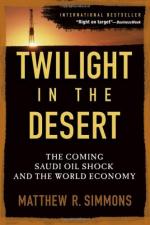
|
| Name: _________________________ | Period: ___________________ |
This test consists of 15 multiple choice questions and 5 short answer questions.
Multiple Choice Questions
1. Who printed in 2005 an article about Saudi Arabian oil fields facing challenges?
(a) The New Yorker.
(b) The New York Times.
(c) Newsweek.
(d) The Economist.
2. When it became clear that Saudi Arabia wasn't going to find enough natural gas to make processing it economically feasible, who did they reach out to?
(a) Western gas companies.
(b) Western investors.
(c) Western oil companies.
(d) Western gas buyers.
3. When free-flowing oil in Saudi Arabia ends, what is the only alternative to find oil?
(a) Cleanup efforts.
(b) Shale and surface drilling.
(c) Rehabilitation efforts.
(d) Secondary recovery efforts.
4. How much unexplored area is there in Saudi Arabia?
(a) None.
(b) Very little.
(c) A lot.
(d) Some.
5. What makes it unlikely that the papers presented to the SPE are exaggerations to make the authors look impressive?
(a) The professionalism of the writers.
(b) The details in the papers.
(c) The SPE screening process.
(d) The sheer volume of papers.
6. According to Saudi Arabian officials, how long did it take before they found oil at Yerbin Field?
(a) 7 years.
(b) 8 years.
(c) 10 years.
(d) 9 years.
7. Detail in papers for the SPE indicate that Saudi Arabia has had what kind of exploration effort over the past 30 years?
(a) Limited.
(b) Extensive.
(c) Complex.
(d) Complicated.
8. The Shaybah field is located where?
(a) The Shallow Quarter.
(b) The Empty Quarter.
(c) The Eastern Quarter.
(d) The Exhausted Quater.
9. The Master Gas System used the natural gas to fuel what industry?
(a) Chemical industry.
(b) Biological industries.
(c) Transportation industry.
(d) Pyrotechnical industry.
10. In the 1950's natural gas was seen as a useful product for what?
(a) Maintaining reservoir pressure.
(b) Identifying problems in oil fields.
(c) Fueling oil drills.
(d) Keeping oil pure.
11. How has modern technology helped in predicting what oil reserves are present?
(a) It has held estimates be closer to fact.
(b) It has enabled oil to be counted exactly.
(c) It hasn't.
(d) It has developed means to find oil through satellites.
12. The super-giant oil fields cannot be part of the alternatives because what process, currently used there, makes them useless?
(a) Water injection programs.
(b) Purification programs.
(c) Multivariate drilling programs.
(d) Natural gas injection programs.
13. In what year did geologists determine that the Arab D Zone has eroded away and been replaced by younger rock?
(a) 1996.
(b) 1998.
(c) 2002.
(d) 2000.
14. Saudi Arabian officials are making impressive predictions about oil fields which have a history of what?
(a) Easily excessible oil and high levels of purity.
(b) Hard to reach oil but large quantities.
(c) Poor quality and excessive quantities.
(d) Problems and poor performance.
15. When Abdullah Jumah was asked to allow outside auditors in to verify the field production data, what was his response?
(a) "Of course we will."
(b) "Why should we?"
(c) "No one understand Saudi oil better than Saudis."
(d) "We have our own auditors."
Short Answer Questions
1. Shaybah is located near Saudi Arabia's border with what nation?
2. Since what year has there been very little data available to verify production levels in Saudi Arabia?
3. How much money did Saudi Arabia invest in gas processing facilities?
4. If the estimates of Saudi Arabian oil reserves made in the 1970's were accurate, what is about to end?
5. A SPE paper says that the best approach to steadily increasing water cuts is to choke back what?
|
This section contains 551 words (approx. 2 pages at 300 words per page) |

|




